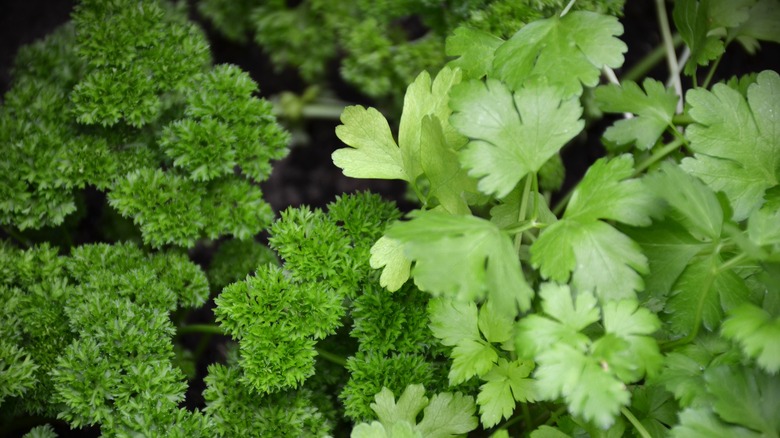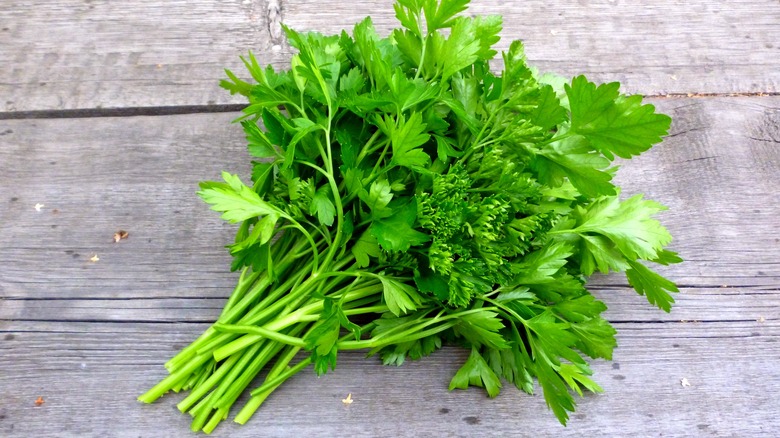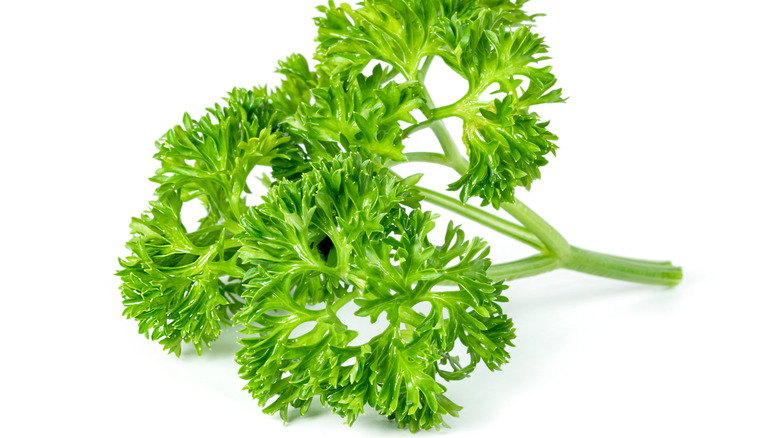Flat Leaf Parsley Vs Curly Leaf: When To Use Each Variety
For many folks, using herbs as a culinary tool doesn't extend too far past the plastic containers of dried plants that can be readily found in your local grocery store. Dried herbs, after all, have a much longer shelf life than the fresh alternative. However, there are a number of kitchen circumstances that certainly call for fresh over dry herbs. Generally speaking, fresh herbs are best when sprinkled in at the end so that a dish's cooking temperature won't rid the herb of its delicate flavor, and dried herbs can and should be stirred into the dish at the beginning of the cooking process.
Knowing how to choose between dried and fresh herbs is far from the only herb knowledge that a chef should have. In fact, within the world of herbs, one must often choose between similar plants with wildly different intended uses. Parsley is a particularly tricky herb that forces you to pick between the flat and curly-leafed varieties. Generally speaking, the more pungent flat-leaf parsley is the herb of choice for adding a fresh flavor to your dishes, while the milder curly leaf is often used as an aesthetic garnish, though it is still featured in countless cuisines.
The bold taste of flat leaf parsley
Other than the difference in taste, flat-leaf parsley has likely gained traction over curly because it is a simpler herb to use. For starters, the curly variety is more likely to snag debris with its small, spiny leaves, and on top of that, washing the extra gritty leaves of curly leaf parsley is a more difficult undertaking than scrubbing the broad, sizable heads of the flat leaf variety.
There is virtually no limit to the number of recipe options you can choose when you need to use your recently purchased bunch of flat-leaf parsley. Fresh parsley should be chopped and sprinkled over your dish once it's finished cooking, as heat will destroy the herb's subtle flavor. Dried parsley can and should be added before cooking so that its flavor can soak into the dish. Dried parsley is almost always made from the flat leaf variety, as its flavor is much bolder than curly parsley when dried.
The beauty of curly leaf parsley
On the other hand, curly leaf parsley has a much more muted flavor profile, and some cooks even claim that it is entirely without flavor. Generally, curly-leaf parsley is used to decorate dishes. A sprig of the vibrant green herb does make a wonderful addition to any number of plates. Additionally, when photographing food for use in media, curly leaf parsley is considerably less delicate than the flat variety, making it the preferable choice. Though it is most commonly used as an aesthetic addition, it could also be used when you need a more mild ingredient for your recipe.
One area where curly parsley once claimed a sizable lead over the flat leaf variety is transportability. Though both varieties are ubiquitous finds at your local grocery stores, that wasn't always the case. In fact, before the 1990s, it was somewhat challenging to find flat-leaf parsley when shopping, as it is much less resilient than its curly cousins and, therefore, more difficult to transport. However, it became more mainstream as home cooks realized that flat leaf contains considerably more flavor, and a better understanding of food storage allows the average person to keep their parsley fresh.


